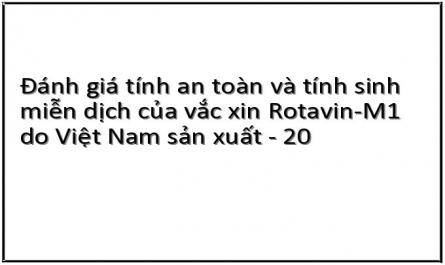108. Linhares AC, Pinheiro FP, Freitas RB, et al (1981), "An outbreak of rotavirus diarrhea among a non-immune, isolated South American Indian community", Am J Epidemiol, 113(6), pp. 703-10.
109. Luan le VTN, Phuong Minh Nguyen, Nguyen Thuy Huong, et al (2009), "Development and Characterization of Candidate Rotavirus Vaccine Strains Derived from Children with Diarrhea in Vietnam", Vaccine.
110. Mary K. Estes (1996), Rotaviruses and their Replication, Lippincott - Raven press, Philadelphia, pp.731 - 754.
111. Murphy TV, Gargiullo PM, Massoudi MS, et al (2001), “Intussusception among infants given an oral Rotavirus vaccine”, N Engl J Med, 344(8), pp. 564-72.
112. Nakagomi, T., and O. Nakagomi. (2009), "A critical review on a globally-licensed, live, orally-administrable, monovalent human rotavirus vaccine: Rotarix", Expert Opin Biol Ther 9: 1073-87.
113. Nguyen TA, Yagyu F, Okame M, et al (2007), “Diversity of viruses associated with acute gastroenteritis in children hospitalized with diarrhoe in HoChiMinh City, Vietnam”, J Med Virol, 79 (5), pp. 582-90.
114. Nguyen Van Man, Dang Duc Anh, et al. (2005), "Epidemiological Profile and Burden of Rotavirus Diarrhea in Vietnam: 5 years of sentinel Hospital Surveillance, 1998-2003", JID 2005:192(suppl 1) s 127-132.
115. Parashar U.D., Bressee J.S., Gentsch J.R., Glass R.I. (1998), “Rotavirus”, Emerg infect Dis.; 4:561-570.
116. Parashar U.D., Hummelman E.G., Bresee J.S., et al (2003), "Global illness and deaths caused by rotavirus disease in children", Emerg Infect, Dis.9:565-572.
Có thể bạn quan tâm!
-
 Đánh Giá Liều Và Lịch Uống Vắc Xin Trên Trẻ Nhỏ
Đánh Giá Liều Và Lịch Uống Vắc Xin Trên Trẻ Nhỏ -
 Qua 3 Giai Đoạn Thử Nghiệm Lâm Sàng Cho Thấy Vắc Xin Rotavin-M1 An Toàn Khi Sử Dụng:
Qua 3 Giai Đoạn Thử Nghiệm Lâm Sàng Cho Thấy Vắc Xin Rotavin-M1 An Toàn Khi Sử Dụng: -
 Đánh giá tính an toàn và tính sinh miễn dịch của vắc xin Rotavin-M1 do Việt Nam sản xuất - 19
Đánh giá tính an toàn và tính sinh miễn dịch của vắc xin Rotavin-M1 do Việt Nam sản xuất - 19
Xem toàn bộ 163 trang tài liệu này.
117. Perez-Schael I, Garcia D, Gonzalez M, et al (1990), “Prospective study of diarrheal diseases in Venezuelan children to evaluate the efficacy of rhesus Rotavirus vaccine”, JMed Virol, 30(3), pp. 219-29.

118. Pesavento JB, Crawford SE, Estes MK, et al (2006), "Rotavirus proteins: structure and assembly", Curr Top Microbiol Immunol, 309, pp. 189-219.
119. Phua, K. B., S. H. Quak, B. W. Lee, S. C. Emmanuel, et al (2005), "Evaluation of RIX4414, a live, attenuated rotavirus vaccine, in a randomized, double-blind, placebo-controlled phase 2 trial involving 2464 Singaporean infants", J Infect Dis 192 Suppl 1: S6-S17.
120. Prasad BV., Chiu W. (1994), Structure of Rotaviruses, springer - Verlag, Berlin, pp. 9 - 29.
121. Prasad BV., Wang GJ., Clerx JP., Chiu W. (1998), "Three dimensional structure of Rotavirus”, J Mol Biol, 199, pp. 269 -275.
122. Prevention of rotavirus disease (2009), "Updated guidelines for use of rotavirus vaccine", Pediatrics; 123(5):1412-20.
123. Rodger SM, Bishop RF, Birch C, et al (1981), “Molecular epidemiology of human Rotaviruses in Melboume, Australia, from 1973 to 1979, as determined by electrophoresis of genome ribonucleic acid”, J Clin Microbiol, 13(2), pp. 272-278.
124. Rodriguez Castillo A., Villa A.V., Ramirez Gonzalez J.E. (2000), “VP4 and VP7 genotyping by reverse transcription PCR of human rotavirus in Mexican children with acute diarrhea”, J. Lin Microbiol, 38: pp.3876- 3878.
125. Roger I. Glass, and Wmesh D. Parashar, M.B. (2006), “The Promise of New Rotavirus Vaccines”, The new England Journal of Medicine.
126. Santos N, Hoshino Y (2005), “Global distribution of rotavirus serotypes/ genotypes and its implication for the development and implementation of an effective rotavirus vaccine”, Rev Med Virol, 15(1), pp. 29-56.
127. Sarah EB, Kelly LW, et al (2006), “Host, rival, and vaccine factors that determine protective efficacy induced by rotavirus-like particles (VLPs)”, Vaccine, 24(8), pp. 1170-1179.
128. Sharma S, Ray P, Gentsch JR, et al (2008), "Emergence of G12 rotavirus strains in Delhi, India, in 2000 to 2007", J Clin Microbiol; 46(4): 1343-8.
129. Steele, A. D., J. Reynders, F. Scholtz, P. Bos, et al (2010), Comparison of 2 different regimens for reactogenicity, safety, and immunogenicity of the live attenuated oral rotavirus vaccine RIX4414 coadministered with oral polio vaccine in South African infants", J Infect Dis, 202 Suppl: S93-100.
130. Suzuki H., Kitaoka S., Konno T., Sato T., et al. (1985), "Two modes of human Rotavirus entry into MA 104 cells", Arch Virol, 85, pp. 25-34.
131. Taraporewala ZF, Patton JT (2004), “Nonstructural proteins involved in genome packaging and replication of rotaviruses and other members of the Reoviridae", Virus Res, 101(1), pp. 57-66.
132. Vesikari T, Isolauri E, D’Hondt E, et a1 (1984), “Protection of infants against rotavirus diarrhoea by RIT 4237 attenuated bovine rotavims strain vaccine”, Lancet, 1(8384), pp. 977-81.
133. Vesikari T, Itzler R, Karvonen A, et al (2009), “RotaTeq®, a pentavalent rotaviras vaccine: efficacy and safety among infants in Europe”, Vaccine, 28(2), pp. 345-51.
134. WHO (1991), Sample size determination in health studies: a practical manual, Geneva.
135. WHO (1998), "Expert committee on biological standardization", WHO Technical Report Series 878, pp. 1-15.
136. WHO (2006), "Guidelines to assure the quality and efficacy of live attenuated Rotavirus vaccines (Oral)", WHO - Technical Report Series, Geneva, pp.1-54.
137. Woode GN, Bridger JC, Jones JM, et al (1976), "Morphological and antigenic relationships between viruses (rotaviruses) from acute gastroenteritis in children, calves, piglets, mice, and foals", Infect Immun, 14(3), pp. 804-10.
138. Zhou Y, Li L, Okitsu S, et al (2003), “Distribution of human Rotaviruses, especially G9 strains, in Japan from 1996 to 2000”, Microbiol Immunol, 47(8), pp. 591-9.



